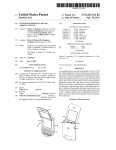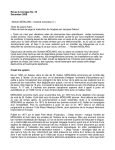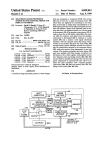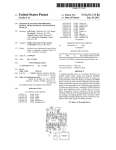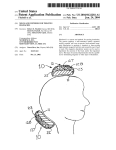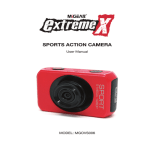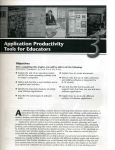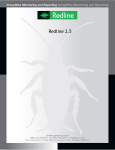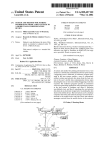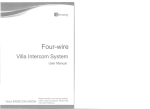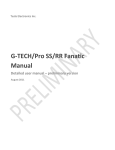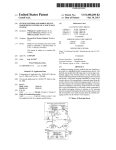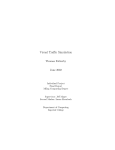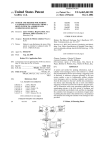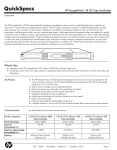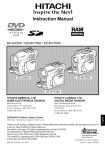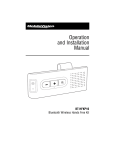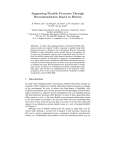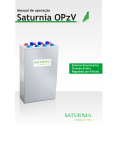Download l Folder`gf
Transcript
US008423011B2
(12) United States Patent
US 8,423,011 B2
#Apr.16,2013
(10) Patent N0.:
(45) Date of Patent:
Bocking et al.
(54) WIRELESS HANDHELD DEVICE, SYSTEM,
370/328; 709/206, 219, 21, 217, 248, 228,
709/225, 203, 218, 207; 726/3; 379/8817,
AND METHOD OF DETECTING AND
STORING EMAIL SETTINGS
379/265.09
See application ?le for complete search history.
(75) Inventors: Andrew D. Bocking, Waterloo (CA);
Anthony G. Burns, Waterloo (CA);
(56)
References Cited
David P. Yach, Waterloo (CA); Phil H.
Nguyen, Kirchener (CA); Piotr K.
U.S. PATENT DOCUMENTS
Tysowski, Waterloo (CA)
5,958,006 A
6,219,694 B1
6,452,588 B2
6,489,950 B1
(73) Assignee: Research In Motion Limited, Waterloo,
Ontario (CA)
(*)
Notice:
Subject to any disclaimer, the term of this
patent is extended or adjusted under 35
2/2003
7,010,303 B2
3/2006 Lewis et a1.
7,355,730 B2 *
7,912,206 B2 *
Filed:
Prior Publication Data
US 2010/0105359 A1
(51)
InfoWorld 16, N0. 5 (Jan. 31, 1994).
(52)
(74) Attorney, Agent, or Firm * Fish & Richardson PC.
(57)
ABSTRACT
A method and apparatus for changing settable email param
eters in a system supporting email using a Wireless device, the
system including a Wireless electronic device and a Wireless
network. Provided is a way of changing email settings on the
Int. Cl.
(2006.01)
Wireless device, and storing those changes on both the device
U.S. Cl.
USPC ......... .. 455/419; 455/466; 455/417; 455/445;
709/206; 709/207; 379/265.09
(58)
(Continued)
Primary Examiner * Mahendra Patel
Continuation of application No. 11/734,868, ?led on
Apr. 13, 2007, now Pat. No. 7,653,402, which is a
continuation of application No. 10/988,305, ?led on
Nov. 12, 2004, now Pat. No. 7,218,926.
H04M 3/00
Miller et a1. ........... .. 379/265.09
(Continued)
Apr. 29, 2010
Related U.S. Application Data
(63)
3/2011
3/2002 Takae et a1.
Barney, Doug, “Remote cc:Mail client goes graphical; 2.0 lets Win
dows users ?lter, preview mail. (Lotus Development Corp. intro
duces cczMail Mobile for Windows 2.0 electronic mail system)”,
Dec. 28, 2009
(65)
Landau et a1. ............. .. 358/l.l4
OTHER PUBLICATIONS
(21) Appl. N0.: 12/647,797
(22)
4/2008
Calabrese et a1. ....... .. 455/432.l
10/2008 Enatsu et a1.
1/2009 Fletcher et a1.
2002/0037714 A1
This patent is subject to a terminal dis
claimer.
Eggleston et a1. .......... .. 709/219
6,519,454 B1 *
7,437,416 B2
7,475,109 B1
U.S.C. 154(b) by 245 days.
9/1999
4/2001 Lazaridis et a1.
9/2002 Grif?n et a1.
12/2002 Grif?n et a1.
Field of Classi?cation Search ............. .. 455/412.1,
and, as needed or desired, on the Wireless network. The Wire
less network and Wireless device are adapted to Wirelessly
communicate With each other.
455/466, 418, 411, 410, 574, 445, 419, 370/252,
19 Claims, 7 Drawing Sheets
FOlOlQl" Reoliinection:
(9 Desktop
@ [j] Moilloox —
John Public
[j Builol Foiled
{1 Deleted Items
1:] Gate Keeper Hell
III
III
g
B
Jovo Dev
Jovo Device Apps
User—De?ned Emoi
Public Relation Clips
l Folder‘gf
m
228
US 8,423,011 B2
Page 2
U.S. PATENT DOCUMENTS
2002/0049806 A1
2002/0090069 A1
2002/0187794 A1*
4/2002 GatZ et al.
7/2002 Yaker
12/2002
Fostick et al. ............... .. 455/466
2003/0023671 A1
1/2003 Abdulrahiman et al.
2003/0084104 A1*
5/2003
2003/0120733
2003/0228011
2003/0231629
2004/0052347
2004/0087337
A1
A1
A1
A1
A1
6/2003
12/2003
12/2003
3/2004
5/2004
www. sfrentrepri ses . fr/ elements/ document s/ e space-client/
utilisateurs/business-mail/logiciel/MSifeatureicomparison.pdf,
2004, 1 p.
Notify Technology Corporation, “NotifyLink Enterprise Mobility
Solution for Microsoft Exchange”, 2004.
Salem et al. ................ .. 709/205
Notify Technology Corporation, “NotifyLink WorkGroup Solution
Forman
Gibson
2002.
for Departmental Wireless Email, Calendar, Contacts, & Tasks”,
1/2006 Sheynblat et al.
Lee, C., Dunker, J ., “CE Software Ships MobileVision(tm)” CE
Software, Inc. Press Release 1995, 3 pgs.
Goin’ Postal version 5 (Freeware) Manual revision, “Goin’ Postal: A
Mailer for DOS HP Palmtops 100LX 200LX 700LX 1000CX”,
undated, 30 pgs.
CE Software, Inc., “Mobile Vision: Direct Wireless Connection to
You LAN-Based Electronic Mailbox”, User Manual, 1995, 49 pgs.
Sullivan, K. B., “Message is out about wireless E-mail”, PC Weeld
Netweek article, Mar. 13, 1995, 2 pgs.
Infowave Software, Inc., “Symmetry User Guide”, PN 9110.01390
rev 1.0, Jun. 22, 2000, 33 pgs.
OTHER PUBLICATIONS
Of?ce Action issued in US. Appl. No. 10/988,305 on May 31,2006;
Robertson, Bruce, “cc:Mail Mobile Offers Best of Remote World”,
Network Computing, Nov. 1, 1994.
CEPT/CCH/GSM, GSM Report 03-42, “Advanced MHX Access”,
version 0.01.05, Jan. 31, 1989.
Motorola Inc., “AirMobile Wireless Comm Client for cc:Mail User
Guide” Version 1.0, 1995.
Of?ce Action issued in US. Appl. No. 10/988,305 on Nov. 16, 2006;
2004/0100650 A1*
2004/0117451 A1*
2004/0266408 A1
5/2004
6/2004
Banerjee et al.
Kimura et al.
Takae et al.
Landau et al. ............. .. 358/1.14
Chung ........................ .. 709/207
12/2004 Maes
2005/0021485 A1*
1/2005
2005/0097170 A1
5/2005 Zhu et al.
2005/0164707 A1*
7/2005
2005/0193144 A1
9/2005 Hassan et al.
2005/0239483 A1*
2006/0009235 A1
10/2005
Nodelman et al. ............ .. 706/21
Batni et al. .................. .. 455/445
Suoste ........................ .. 455/466
Cingular Xpress Mail System Pocket PC.
9 pages.
Motorola Inc., “AirMobile Wireless Comm Server for cc:Mail User
Guide” Version 1.1, 1995 [best available copy].
Chess, David, Harrison, Colin and Kershenbaum, Aaron, “Mobile
Agents: Are they a good idea?”, IBM Research Report, RC 19887
(Oct. 1994).
Oracle Corporation, “Oracle Mobile Agents: Technical Product Sum
mary”, Mar. 1995.
Fine, Mike, “The AllPoints Wireless PC Card and RadioMail Ser
vice”, The HP Palmtop Paper, Jul./Aug. 1996, pp. 19-21.
Gibbons, A. et al., “How to Use Outlook Out of Of?ce Assistant”,
http://web.archive.org/web/20040218234413/http://ittraining.1se.
ac .uk/docurnentation/Files/Outlook-Out-of-Of?ce-Assistant.pdf,
Dec. 2002, 4 pp.
Dunlap, T., “OQO device, subnotebooks hit CES”, http://www.cnet.
con?4520-7912i-1-5116369-1.html, Jan. 8, 2004, 3 pp.
De Herrera, C., “Windows Mobile 2003 Screen Shots”, http://www.
archive.org/web/20031009121607/ http://www.cewindows.net/wce/
42/windowsmobile2003inboxscreens.htm, Jul. 28, 2003, 8 pp.
Research in Motion Limited, “BlackBerry Enterprise Server for
Exchange
Overview”,
http://web.archive.org/web/
20041026192830/http://www.blackberry.net/products/software/
9 pages.
Advisory Action issued in US. Appl. No. 10/988,305 on Feb. 2,
2007; 3 pages.
Notice ofAllowance issued in US. Appl. No. 10/988,305 on Mar. 7,
2007; 6 pages.
Of?ce Action issued in US. Appl. No. 11/734,868 on Mar. 31, 2009;
7 pages.
Notice ofAllowance issued in US. Appl. No. 11/734,868 on Oct. 6,
2009; 6 pages.
Of?ce Action issued in US. Appl. No. 13/244,785 on Nov. 7, 2011;
7 pages.
Of?ce Action issued in Canadian Application No. 2,526,405 on Jun.
11, 2008; 2 pages.
Of?ce Action issued in Chinese Application No. 2005101204064 on
Jan. 8, 2010; 7 pages.
Of?ce Action issued in Chinese Application No. 2005101204064 on
Nov. 2, 2011; 5 pages.
European Search Report issued in European Application No.
042570390 on May 10, 2005; 9 pages.
Communication Pursuant to Article 94(3) EPC issued in European
Application No. 042570390 on Jan. 4, 2008; 6 pages.
Summons to Attend Oral Proceedings issued in European Applica
tion No. 042570390 on Nov. 16,2011; 8 pages.
Communication Pursuant to Article 94(3) EPC issued in European
Application No. 08104977.7 on Oct. 20, 2011; 7 pages.
Of?ce Action issued in US. Appl. No. 13/244,785 on Oct. 19, 2012;
14 pages.
server/exchange/overview.shtrnl, 2004, 5 pp.
Research in Motion Limited, “BlackBerry Enterprise Server for
Microsoft Exhange”, Version 4.0, Feature and Technical Overview,
Of?ce Action issued in US. Appl. No. 13/244,785 on Apr. 25, 2012;
2004, 51 pp.
Of?ceAction issued in U.S.Appl.No.13/244,785 on Feb. 5, 2013; 16
Flaherty, C. et al., “SlackBerry Enterprise Server v4.0 Release Can
didate Now Available”, XP-002497517, Business Wire, Sep. 27,
pages.
2004, 6 pp.
tion No. 042570390 on Jan. 23, 2013; 8 pages.
Research in Motion Limited, “BlackBerry Enterprise Server version
3.6 for Microsoft Exchange”, XP-002497503, 2003, 18 pp.
Research in Motion Limited, BlackBerry® Enterprise Server for
tion No. 08104977.7 on Jan. 23, 2013; 8 pages.
Microsoft® Exchange Feature Comparison, XP002497521, http://
* cited by examiner
8 pages.
Summons to Attend Oral Proceedings issued in European Applica
Summons to Attend Oral Proceedings issued in European Applica
US. Patent
Apr. 16,2013
Sheet 1 017
US 8,423,011 B2
4
\
12
5
\
\
28
I
I
24
US. Patent
Apr. 16, 2013
Sheet 2 0f 7
INPUT
APPARATUS
CALENDAR
ADDRESS
BOOK
TASKS
MEMOS
MESSAGES
SEARCH
/
F102
100
US 8,423,011 B2
US. Patent
Apr. 16, 2013
4'3
US 8,423,011 B2
Sheet 3 0f 7
‘fiiB
Hide Menu
Mark Prior Upened
PM
i2] 3:10p
El 3:10p
IYI 3=10p
Eswp
Delete Prior
Compose Ema?
Compose PIN
FWace CaU
Compose SMS
Search
View Folder
“4
View Saved Messages
/nptionS////////// f1”
Help
Close
116j
~f120
FM. 3
Message Up?oms
General UptiOnS///////// fize
Email Reconciliation\128
Email Filters—fly)
Email Settings /132
F]G.4
EmaH F?lers
iF no Filters apply, semd email to
handheld: .l148
154/
152RYGS }144
its"1’7/////////////i146
Filter8\
L35
liso
F165
US. Patent
Apr. 16,2013
-
Sheet 4 on
-
US 8,423,011 B2
i
1§8
Emml Fltters
Hide Menu/
160
i? no Filter/‘5 apply, senol Move down
162
handheld;
DlSQIOlQ Fllterlf
172x
15’“
5/ / /{IM8
:1915'66
“WWW / Delete/168
Filter‘gy
I
150
\CQSQWQNN
J F]G.6
156E
136
.
Fllterc
Nome=h84
e [175
1781From:
180\~Sent to:
782\/Suloject:
184’\-Message:
186\\{___I Sent directly to me
188\{] CC: to me
190\H;:] ECU to me
Importance:
None “Mm
Sensitivity:
None if!“
Action:
Do not Forward—f196
FIG. 7
m
US. Patent
Apr. 16, 2013
Sheet 5 0f7
US 8,423,011 B2
Email Settings
198
200\'Senol EmaiL to Handheld:
Yes
\-Save Copy in Sent Foloier=
202/‘Use Auto Signature:
Yes
Yes
205_\’ > My Signature
204/‘Use Elut
"'13 l]? [IFFice
FIGHReply:
206
Email
SGJCJCH’WQS
/Ch
/i-iioie (Mien’u,
[I t'I I
f
Senoi Email to Hanolhel
Iapgle'i’l'W/ji
Save Copy in Sent F0 Fololer Redirection_/\2H
205
Use Auto Signature:
\/
_
> My Signature
save
~P212
Close
e
u se I] u t [1? UFF'ice R epy
i :
J
138
FIGQ
/i<i”’
///0A/
“294
\214
US. Patent
Apr. 16, 2013
Sheet 6 0f7
US 8,423,011 B2
Foloier Reoiii/‘ectionl
6 Desktop
@ [mailbox "
John Public
CI Builoi Faileoi
{I Deleteoi Items
CI Gate Keeper" Hell
Inioo><~/“226
C] Java Dev
C] Java Device Apps
/// /
// Ill /
1228
/ ////////7/777/ / /////
V //User—DeFineoi
Email Foloier¢
/// / / // /1/ //// // / /////// //
B Public Relation Clips
FIGJO
M
Email Settings
198\/Senoi Email to Handheloh
200\-Save Copy in Sent FOlOlE’i":
202”\'Use Auto Signaturel
Yes
Yes
Yes
205’\-‘> My Signature
Eiut 0F oFFice replyf204
Yes
Fri. Dec 10,2004‘ [222
Due date:
} Note—I will be out 0? the oFFic\e.....|
l
FIG]!
/
138'
22°
US. Patent
Apr. 16, 2013
Sheet 7 0f 7
US 8,423,011 B2
US 8,423,011 B2
1
2
WIRELESS HANDHELD DEVICE, SYSTEM,
example, a desktop personal computer. Accordingly, there is
AND METHOD OF DETECTING AND
STORING EMAIL SETTINGS
room for improvement in wireless handheld electronic
devices and related systems and methods.
This application is a continuation of application Ser. No.
11/734,868, ?ledApr. 13, 2007 now US. Pat. No. 7,653,402,
and entitled “Coordinated Changing Of Email Settings On
Wireless Electronic Devices And Wireless Networks”, which
is a continuation of application Ser. No. 10/988,305, ?led
SUMMARY OF THE INVENTION
These needs and others are met by the invention, which
provides a user interface on a wireless handheld electronic
Nov. 12, 2004 now US. Pat. No. 7,218,926, and entitled
device, in order to remotely control e-mail settings for the
device without using a software utility at, for example, a
“Method, Wireless Handheld Electronic Device And System
Of Remotely Controlling E-Mail Settings From The Device”.
desktop personal computer.
In accordance with one aspect of the invention, a method of
changing e-mail settings on a wireless handheld device com
BACKGROUND OF THE INVENTION
prises: detecting an email setting displayable on the wireless
handheld device; saving the detected email setting in the
wireless handheld device, such that the detected email setting
is retrievable at a later time; sending, using a wireless output
communications port of the wireless handheld device, the
1. Field of the Invention
The invention relates generally to handheld electronic
devices and, more particularly, to a handheld electronic
device including an e-mail function. The invention also
relates to a method or a system of remotely controlling e-mail
settings from such a handheld electronic device.
20
server and uniquely associable with the sending wireless
handheld device; and using, as needed by a message applica
tion of the wireless handheld device, the detected email set
2. Background Information
Numerous types of handheld electronic devices are known.
Examples of such handheld electronic devices include, for
instance, personal digital assistants (PDAs), handheld com
puters, two-way pagers, cellular telephones, and the like.
ting.
25
Many handheld electronic devices also feature wireless com
memory; a display; at least one input device con?gured to be
usable by a user of the wireless handheld device; software
tronic devices are stand-alone devices that are functional
30
35
40
personal computer that interfaces with a wireless enterprise
server over, for example, the Internet. Such e-mail settings
may include, for example, e-mail ?lter settings, e-mail redi
rection settings, save copy of e-mail in a sent folder settings,
45
settings. For example, an e-mail ?lter setting is a setting that
blocks certain e-mail messages based upon user-selected cri
teria. An e-mail redirection setting enables and disables the
redirection of e-mail messages from a user’s normal e-mail
system to the user’s wireless handheld electronic device.
Such settings may also redirect e-mail messages from
a speci?c wireless device; receiving, on the wireless network,
a communication comprised of at least one email setting
associable with the speci?c wireless device, where the
received at least one email setting has the property of being
changeable by an input device on the speci?c wireless device;
disables appending prede?ned text to an e-mail message that
55
of-of?ce reply e-mail setting enables or disables sending a
prede?ned reply e-mail message from a wireless handheld
electronic device in response to an e-mail message that is
received by such device. For example, the out-of-o?ice reply
e-mail setting is con?gurable via a program, such as, for
email settings by the at least one input device, to save detected
changes to email settings in a manner usable by the software,
and to send, through the output port, wireless communica
tions con?gured to be receivable by a wireless server where
the detected changes to the email settings are uniquely asso
ciable with the wireless handheld device.
As another aspect of the invention, a method of changing
e-mail settings on a wireless network comprises: providing
storage for email settings on the wireless network, the storage
enabled for retrievably storing email settings associated with
50
selected folders (e.g., Inbox; Spam) in the user’s normal
e-mail system. An e-mail auto-signature setting enables and
is sent from a wireless handheld electronic device. An out
at least one input device, and structured to retrieve and run the
software, where the software is further con?gured to run on
the processor, and further where the software and the proces
sor are con?gured to be able to retrieve and save a plurality of
email settings, the email settings further saved in a manner
usable by the message application, to enable display of
changeable email settings and detection of changes to the
It is known to con?gure e-mail settings for wireless hand
e-mail auto-signature settings, and out-of-of?ce reply e-mail
comprising at least a message application, retrievably stored
in the memory; and a processor operatively coupled to the
wireless input and output ports, the memory, the display, the
tronic messages received for reading and processing by the
recipient. Such processing can include, for example, replying
to, forwarding to others, deleting and ?ling the messages.
held electronic devices from a software utility at a desktop
As another aspect of the invention, a mobile wireless hand
held device comprises: wireless input and output ports; a
munication capability, although many such handheld elec
without communication with other devices.
Electronic mail (email or e-mail) is used to send messages
over networks and over the Internet. Electronic messaging
has become a ubiquitous means of communication for both
business and personal use. Devices that process electronic
messages typically maintain a message list identifying elec
detected email setting in a manner receivable by a wireless
60
saving, in the storage, the received at least one email setting in
a manner associated with the speci?c wireless device; and
retrieving, at a time later than the saving, the saved at least one
email setting and enabling for retrieval any other information
in the storage associated with the speci?c wireless device.
As another aspect of the invention, a method of remotely
example, Microsoft® Outlook® or Lotus Notes® on a per
controlling e-mail settings comprises: maintaining at least
sonal computer. The other e-mail settings (e.g., auto-signa
one of the e-mail settings at a wireless enterprise server;
associating at least one of the e-mail settings with the wireless
handheld electronic device; and enabling remote control of at
least one of the e-mail settings at the wireless enterprise
server through wireless communication between the wireless
enterprise server and the wireless handheld electronic device.
ture; redirected folders; e-mail redirection) are controlled via
desktop software on a personal computer.
There exists the need for users of wireless handheld elec
tronic devices to remotely control their e-mail settings from
such devices without having to use a software utility at, for
65
US 8,423,011 B2
3
4
The e-mail setting may be an e-mail ?lter setting, and the
wireless handheld electronic device may be employed to cre
ate, display, edit or delete the e-mail ?lter setting.
The e-mail setting may be an e-mail redirection setting, and
the wireless handheld electronic device may be employed to
adapted to update the at least one of the e-mail settings in the
database based upon the changes.
The at least one server may further comprise an e-mail
server. The at least one of the e-mail settings may comprise an
out-of-of?ce reply e-mail setting. The wireless handheld
enable or disable the e-mail redirection setting. At least one
electronic device may be further adapted to input a change to
folder corresponding to a predetermined category of e-mail
messages may be included with the e-mail redirection setting.
The wireless handheld electronic device may be employed to
the out-of-of?ce reply e-mail setting and to wirelessly send
the change to the wireless enterprise server. The wireless
enterprise server may be adapted to forward the change to the
select at least one of the at least one folder.
At least one folder for at least one e-mail message may be
e-mail server.
As another aspect of the invention, a wireless handheld
electronic device comprises: an input apparatus; a wireless
communication port; a memory including a plurality of
e-mail settings associated with the wireless communication
port; and a processor cooperating with the input apparatus,
the wireless communication port and the memory to remotely
associated with the e-mail redirection setting. An e-mail mes
sage for one of the at least one folder may be forwarded or
redirected to the wireless handheld electronic device. The
wireless handheld electronic device may be employed to
enable or disable the forwarding or redirecting for the one of
the at least one folder.
control at least one of the e-mail settings at a wireless server
The e-mail setting may be an out-of-of?ce reply e-mail
setting, and the wireless handheld electronic device may be
employed to create, enable, edit or disable the out-of-o?ice
through wireless communication with the wireless commu
nication port.
20
reply e-mail setting. The out-of-of?ce reply e-mail setting
BRIEF DESCRIPTION OF THE DRAWINGS
may be automatically disabled at a predetermined date. The
wireless handheld electronic device may be employed to edit
A full understanding of the invention can be gained from
the predetermined date.
The e-mail setting may be associated with saving a copy of
25
a sent e-mail in a sent folder. The wireless handheld electronic
device may be employed to enable or disable the e-mail
setting associated with saving a copy of a sent e-mail in a sent
folder.
The e-mail setting may be an auto signature e-mail setting.
The wireless handheld electronic device may be employed to
enable or disable the auto signature e-mail setting. A text ?eld
may be associated with the auto signature e-mail setting, and
the wireless handheld electronic device may be employed to
30
edit the text ?eld.
35
40
wirelessly communicate with the wireless handheld elec
tronic device. The wireless handheld electronic device is
adapted to remotely control at least one of the e-mail settings
at the at least one server through wireless communication
between the at least one server and the wireless handheld
45
electronic device.
FIG. 8 and the corresponding menu screen.
settings may comprise an out-of-of?ce reply e-mail setting.
50
adapted to input a change to the out-of-of?ce reply e-mail
setting and to wirelessly send the change to the wireless
FIG. 11 is an example of the Email Settings display screen
that is displayed after making a selection from the corre
sponding menu screen of FIG. 9.
55
FIG. 12 is a block diagram showing a wireless handheld
electronic device, a wireless enterprise server and database
store, a mail server and a personal computer (PC) in accor
dance with an embodiment of the invention.
60
DESCRIPTION OF THE PREFERRED
EMBODIMENTS
remote personal computer or from a remote client device
As employed herein, the terms “e-mail setting” or “e-mail
The at least one server may comprise a wireless enterprise
server. The wireless handheld electronic device may be fur
ther adapted to input a plurality of changes to the e-mail
settings and to wirelessly send the changes to the wireless
enterprise server. The wireless enterprise server may be
FIG. 10 is an example of a Folder Redirection display
screen that is displayed after making a selection from the
menu screen of FIG. 9.
enterprise server. The wireless enterprise server may be
adapted to forward the change to the e-mail server.
including mail client software. The wireless enterprise server
may be further adapted to periodically monitor the out-of
of?ce reply e-mail setting of the e-mail server and to wire
lessly send a change thereof to the wireless handheld elec
tronic device.
FIG. 5 an example of an Email Filters display screen that is
displayed after making a selection from the menu screen of
FIG. 4.
FIG. 6 an example of the Email Filters display screen of
FIG. 5 and the corresponding menu screen.
FIG. 7 an example of a Filter display screen that is dis
played after making a selection from the menu screen of FIG.
6.
FIG. 8 is an example of an Email Settings display screen
that is displayed after making a selection from the menu
FIG. 9 an example of the Email Settings display screen of
server and an e-mail server. The at least one of the e-mail
The e-mail server may be adapted to independently update
a change to the out-of-of?ce reply e-mail setting from a
screen of FIG. 3.
screen of FIG. 4.
The at least one server may comprise a wireless enterprise
The wireless handheld electronic device may be further
which:
FIG. 1 is a top plan view of a wireless handheld electronic
device in accordance with the invention.
FIG. 2 is a schematic depiction of the wireless handheld
electronic device of FIG. 1.
FIG. 3 is an example of a Message List and a corresponding
menu screen of the display of FIG. 1.
FIG. 4 is an example of a Message Options menu screen
that is displayed after making a selection from the menu
As another aspect of the invention, a system comprises: a
wireless handheld electronic device comprising a plurality of
e-mail settings associated therewith; and at least one server
comprising a database maintaining at least one of the e-mail
settings, at least one of the at least one server being adapted to
the following description of the preferred embodiments when
read in conjunction with the accompanying drawings in
settings” mean one, some or all of e-mail ?lter setting(s),
65
e-mail redirection setting(s), e-mail setting(s) associated with
saving a copy of a sent e-mail in a sent folder, auto-signature
e-mail setting(s), and out-of-o?ice reply e-mail setting(s).
US 8,423,011 B2
6
5
viding a suitable input through the input apparatus 16, such as
by suitably rotating the thumbwheel 32 and providing a selec
tion input by translating the thumbwheel 32 in the direction
The invention is described in association with a wireless
handheld electronic device, although the invention is appli
cable to a wide range of handheld electronic devices.
A wireless handheld electronic device 4 is indicated gen
indicated by the arrow 38. For example, the home screen
erally in FIG. 1 and is depicted schematically in FIG. 2. The
output 64 displays the icon 110 associated with the Messages
example device 4 includes a housing 6 upon which are dis
posed a processor unit that includes an input apparatus 8, an
output apparatus 12, a processor 16 (as shown in FIG. 2), a
application 98.
memory 20 (FIG. 2), and a plurality of routines 22 (FIG. 2).
The processor 1 6 may be, for instance, and without limitation,
a microprocessor (uP) that responds to inputs from the input
apparatus 8 and provides output signals to the output appara
message list 114 is displayed by the processor 16 responsive
to the initiation of the Messages application 98 (FIG. 2), as
FIG. 3 is an example of a message list 114 and a corre
sponding menu screen 116 of the display 60 of FIG. 1. The
was discussed above. The menu screen 116 is displayed by
the processor 16 from the Messages application 98 responsive
to the processor detecting another input through the input
apparatus 16, such as by providing a selection input by trans
tus 12, which includes a wireless communications port 23
(FIG. 2). The processor 16 also interfaces with the memory
20. Examples of handheld electronic devices are included in
US. Pat. Nos. 6,452,588 and 6,489,950, which are incorpo
lating the thumbwheel 32 in the direction indicated by the
rated by reference herein.
menu items including, for example, a Hide Menu item 118,
arrow 38 (FIG. 1). Within the menu screen 116, there are
As can be understood from FIG. 1, the input apparatus 8
which when selected causes the menu screen 116 to be
includes a keypad 24 and a thumbwheel 32. The wireless
handheld electronic device 4, as shown, employs a user inter
removed from the display 60, a Close item 120, which when
selected causes the Messages application 98 to close and the
home screen output 64 (FIG. 1) to be redisplayed, and an
Options item 122. When the Options item 122 is selected, in
20
face including, for example, the keypad 24 and the thumb
wheel 32 foruser interface navigation. As an alternative to the
thumbwheel 32, a wide range of cursor positioning and/or
function selecting mechanisms or other suitable user input
devices (e.g., a touch pad; a joystick button), whether pres
ently known or unknown, may be employed.
Continuing to refer to FIG. 1, the keys 28 are disposed on
a front face of the housing 6, and the thumbwheel 32 is
disposed at a side of the housing 6. The thumbwheel 32 can
serve as another input member and is both rotatable, as is
25
the same manner that has been described, the Message
Options menu screen 124 of FIG. 4 is displayed.
The menu screen 124 includes a General Options item 126,
an Email Reconciliation item 128, an Email Filters item 130,
and an Email Settings item 132. The General Options item
126, when selected, permits the user to set conventional
e-mail client settings (e.g., Display Time; Display Name;
30
indicated by the arrow 34, to provide selection inputs to the
processor 16, and also can be pressed in a direction generally
toward the housing 6, as is indicated by the arrow 38, to
provide another selection input to the processor 16.
Another key, the <ESC> key 45 is disposed on the side of
the housing 6 adjacent the thumbwheel 32, although the same
or similar key may be disposed as part of the keypad 24.
The memory 20 (FIG. 2) can be any ofa variety oftypes of
internal and/or external storage media such as, without limi
35
tation, RAM, ROM, EPROM(s), EEPROM(s) and/ or the like
40
Con?rm Delete) on the handheld electronic device 4. The
Email Reconciliation item 128, when selected, provides a
conventional bi-directional e-mail reconciliation between the
user’s main e-mail processor (e.g., a personal computer (PC)
134 (FIG. 12), desktop or workstation) and the handheld
electronic device 4. Although the items 126 and 128 are
shown, one or both of these items need not be employed.
Selecting the Email Filters item 130 causes the Email Filters
display 136 of FIG. 5 to be displayed. Similarly, selecting the
Email Settings item 132 causes the Email Settings display
138 of FIG. 8 to be displayed.
that provide a storage register for data storage such as in the
As will be explained, starting from the Message Options
fashion of an internal storage area of a computer, and can be
volatile memory or nonvolatile memory. The memory 20
menu screen 124, the user may control various different
e-mail settings such as, for example, e-mail ?lter settings
additionally includes the routines 22 for the processing of
data. The routines 22 can be in any of a variety of forms such
45
as, without limitation, software, ?rmware, and the like.
Referring again to FIG. 1, the output apparatus 12 includes
a display 60 upon which is provided an example output 64.
The display 60 may also include a caret (e. g., cursor) 84 (FIG.
7) that depicts generally where the next input from the input
(FIGS. 5-7), auto signature e-mail settings (FIG. 8), e-mail
folder redirection settings (FIG. 10) and out-of-of?ce reply
e-mail settings (FIG. 11). As will be discussed, below, in
connection with FIG. 12, the e-mail settings 248, which are
50
created, displayed, edited and/or deleted by the wireless
handheld electronic device 4, permit the software utility 140
of the PC 134 (FIG. 12) to not be required for day-to-day
apparatus 8 will be received. The output 64 of FIG. 1 is
usage. As a result, users can con?gure important e-mail set
depicted as displaying a home screen that represents a num
tings from the wireless handheld electronic device 4. Those
e-mail settings 248 may also be found, for example, in a
Redirector Settings component 142 of the PC software utility
ber of applications 86 (FIG. 2) depicted as corresponding
discrete icons 88. The applications 86 include, for example, a
Calendar application 90, an Address Book application 92, a
Tasks application 94, a MemoPad (Memos) application 96, a
Messages application 98 and a Search application 100. The
55
140.
Referring to FIGS. 5-7, the user can create (FIGS. 6 and 7),
display (FIGS. 5-7), edit (FIGS. 6 and 7) and delete (FIG. 6)
corresponding icons 88 include, for example, the Calendar
icon 102, the Address Book icon 104, the Tasks icon 106, the
various e-mail ?lters. As shown in the Email Filters display
136 ofFIG. 5, there is a ?rst display portion 144 and a second
icon 112, respectively. Although various applications and
display portion 146 including two example ?lters 148 (Fil
ter1) and 150 (Filter2). The ?rst display portion 144 shows
icons are shown, a wide range of fewer or greater applications
that if no ?lters apply, then an e-mail message will be sent to
and icons may be employed.
In FIG. 1, the home screen output 64 is currently active and
redirection setting 152 (Yes). If, however, the setting 152 was
MemoPad icon 108, the Messages icon 110 and the Search
would constitute another one of the applications 86. One of
60
the wireless handheld electronic device 4 as indicated by the
65
“No,” then e-mail messages that do not meet the various ?lter
the other applications 86, such as the Messages application
criteria are not forwarded or redirected to the wireless hand
98, can be initiated from the home screen output 64 by pro
held electronic device 4. In this example, there are two
US 8,423,011 B2
7
8
enabled (e.g., as indicated by the example checks, such as
result, e-mail messages from [email protected] sent
154) ?lters 148,150, although there may be one or more ?lters
each of which may be independently enabled or disabled
directly to the user of the device 4 would not be forwarded to
the user’s wireless handheld.
(e.g., the absence of a check (not shown)).
EXAMPLE 2
As shown in FIG. 6, a menu screen 156 can be initiated
from the display 136 by providing a suitable input through the
input apparatus 16, such as by suitably rotating the thumb
wheel 32 (FIG. 1) (e.g., to select Filter1 148, as shown) and
providing a selection input by translating the thumbwheel 32
For example, Filter2 150 would include “Filter2” in ?eld
176 (FIG. 7) and may include “Low Rate Mortgage” in the
subject ?eld 182. As a result, any e-mail messages including
that text in the subject ?eld would not be forwarded.
in the direction indicated by the arrow 38. The menu screen
156 for the enabled Filter1 148 includes a Hide Menu item
158, a Move down item 160, a Disable ?lter item 162, a New
item 164, an Edit item 166, a Delete item 168 and a Close 170
FIGS. 5-7 show that users can now perform any or all of the
following actions directly from the device 4 without requiring
any PC 134 (FIG. 12): (1) view e-mail ?lters (FIGS. 5-7); (2)
edit e-mail ?lters (FIGS. 6 and 7); (3) delete e-mail ?lters
(FIGS. 6); and (4) create new e-mail ?lters (FIGS. 6 and 7).
The Email Settings display 138 of FIG. 8 is displayed after
to exit from the Email Filters display 136. Selecting one of
those items (even numbers 158-170) provides one of the
following seven actions: (1) the Hide Menu item 158 removes
the menu screen 156 from the display 60 (FIG. 1); (2) the
Move down item 160 causes the selected e-mail ?lter to be
moved down in priority below the next e-mail ?lter (e.g.,
Filter2 150 would be executed prior to Filter1 148, in order to
20
ciated with saving a copy of a sent e-mail in a sent folder (e. g.,
attempt to ?lter out forwarding of an e-mail message to the
Save Copy In Sent Folder), an auto signature e-mail setting
202 (e.g., Use Auto Signature), and an out-of-of?ce reply
e-mail setting 204 (e.g., Use Out Of Of?ce Reply). Those
device 4); (3) the Disable ?lter item 162 disables the selected
e-mail ?lter (e.g., causing the check 172 to be removed (not
shown)); (4) the New item 164 displays the Filter display
selecting the corresponding item 132 from the menu screen
124 of FIG. 4. The display 138 includes various e-mail set
tings, such as, for example, an e-mail redirection setting 198
(e.g., Send Email To Handheld), an e-mail setting 200 asso
25
e-mail settings 198,200,202,204 may individually be enabled
screen 174 of FIG. 7 and allows the user to create a new email
(e.g., Yes) or disabled (e.g., No). Although example e-mail
?lter; (5) the Edit item 166 displays a display screen (not
shown) for the selected e-mail ?lter that is similar to the
setting selections are shown, none, one, some or all may be
enabled and none, one, some or all may be disabled. Since the
screen 174 except that it includes information previously
entered for that selected e-mail ?lter; (6) the Delete item 168
30
example, My Signature).
causes the selected e-mail ?lter to be deleted and removed
from the screen 136; and (7) the Close item 170 removes the
FIG. 9 shows the display screen 138 of FIG. 8 and the
corresponding menu screen 206 that is displayed by the pro
display 136 and redisplays the menu screen 124 (FIG. 4). If
the selected e-mail ?lter is disabled (not shown), then the
cessor 16 (FIG. 2) responsive to the processor detecting
another input through the input apparatus 16, such as by
providing a selection input by translating the thumbwheel 32
Disable ?lter item 162 is displayed as “Enable ?lter”. If the
selected e-mail ?lter is at the bottom of the screen 136 (e.g.,
such as Filter2 150), then the Move down item 160 is dis
played as “Move up”.
As shown in the Filter display screen 174 of FIG. 7, each of
auto signature e-mail setting 202 is enabled, also displayed is
the corresponding auto signature text 205 (e.g., in this
in the direction indicated by the arrow 38 (FIG. 1). The menu
screen 206 includes menu items 208,210,211,212,214.
Selecting one ofthose menu items 208,210,211,212,214 pro
40
vides one of the following ?ve actions: (1) the Hide Menu
the e-mail ?lters includes a number of entry ?elds, such as
176,178,180,182,184, that de?ne the new or previously cre
item 208 removes the menu screen 206 from the display 60
ated e-mail ?lter. For example, the ?eld 176 de?nes the e-mail
?lter name (e.g., Filter1; Filter2, as shown in FIG. 6). Zero,
selected one of the e-mail settings 198,200,202,204 (e.g.,
one, some or all of the ?elds 178,180,182,184 may be
employed to ?lter an e-mail message based upon the sender as
(FIG. 1); (2) the Change Option item 210 either toggles the
45
selected by ?eld 178, the recipient as selected by ?eld 180, the
message subject as selected by ?eld 182, and the message
contents as selected by ?eld 184. Furthermore, zero, one,
some or all of the check boxes 186,188,190 may be employed
selected e-mail setting 204, in this example, would toggle
from No toYes); (3) the Folder Redirection item 211 brings up
the display screen 224 shown in FIG. 10; (4) the Save item
212 saves the current e-mail settings 198,200,202,204 in the
memory 20 (FIG. 2) of the device 4 and, also, remotely
controls the corresponding e-mail settings in the wireless
50
to ?lter an e-mail message that is sent directly to the user as
selected by check box 186, that is (“carbon”) copied (“CC”)
enterprise server 216 and/or mail server 218 (FIG. 12); and
(5) the Close item 214 removes the display screen 138 and
redisplays the menu screen 124 (FIG. 4).
to the user as selected by check box 188 and/ or that is (“blind
carbon”) copied (“BCC”) to the user as selected by check box
190. Also, one or both of the ?elds 192,194 may be employed
EXAMPLE 3
55
to ?lter an e-mail message that includes an importance setting
For example, if the user edits one, some or all or the e-mail
(e.g., high; normal; low; none) as selected by ?eld 192 or a
settings 198,200,202,204 and/or the text ?elds 205 or 220
sensitivity setting (e.g., personal; con?dential; private; nor
(FIG. 11) and then selects the
Save item 212, that information is saved in the memory 20
mal; ThankYou! ; none) as selected by ?eld 194. Further, there
is a ?eld 196 that de?nes the action taken (e.g., do not for
ward) if the test of the corresponding e-mail ?lter is true.
60
4 to the wireless enterprise server 216 as will be discussed,
EXAMPLE 1
For example, Filter1 148 would include “Filter1” in ?eld
176 (FIG. 7) and may include “[email protected]” in the
from ?eld 178 and the check box 186 being checked. As a
(FIG. 2) and, also, is wirelessly communicated by the device
65
below, in connection with FIG. 12.
If the e-mail setting Send Email To Handheld 198 is
enabled (Yes), then if none of the rules of the e-mail ?lters
(e.g., FIG. 5) apply, then the e-mail message is forwarded or
redirected to the device 4 by the wireless enterprise server 216
(FIG. 12). FIGS. 8 and 9 show that the user can view and
US 8,423,011 B2
10
change the e-mail redirection setting 198 by selecting the
particular e-mail setting with the thumbwheel 32, displaying
Exchange Server®) as that e-mail setting 204 is not a wireless
enterprise-related setting and, instead, is a mail server setting.
In this example, the e-mail setting 204 is the only e-mail
the menu 206, and selecting the Change Option item 210.
If the e-mail setting Save Copy In Sent Folder 200 is
setting that affects the core mail server behavior. The other
e-mail settings are enterprise e-mail settings and are stored in
the mail server 218 (in the user’s account) in order that the
desktop software utility 140 can access them, but are only
executed on by the enterprise server 216, the device 4, and
enabled (Yes), then the processor 16 (FIG. 2) saves a copy of
the e-mail message in a sent folder 217 (FIG. 2) in the
memory 20 of the device 4. FIGS. 8 and 9 show that the user
can view and change the e-mail setting 200.
If the e-mail setting Use Auto Signature 202 is enabled
(Yes), then the text 205 is appended by the e-mail server 218
(FIG. 12) to any e-mail messages that are sent by the device 4.
(optionally) the desktop software utility 140.
Although not required, alternatively, the various e-mail
setting(s) may also be updated by the user via the wireless
enterprise’ s desktop software utility 140, if that is installed on
the user’s PC 134. For example, at 238, the user modi?es the
out-of-of?ce reply e-mail setting 204 at the user’s PC 134
FIGS. 8 and 9 show that the user can view and change the
e-mail setting 202 and/or create, view and edit the corre
sponding text ?eld 205 operatively associated with the setting
and/or the wireless enterprise’s desktop software utility 140
running suitable mail client software (e.g., Microsoft® Out
look®). The only e-mail setting that would be made via the
202. For example, the text ?eld 205 could be edited to alter
natively state “Sent From My Wireless Handheld”.
If the e-mail setting Use Out Of Of?ce Reply 204 is enabled
(Yes), then the mail server 218 (FIG. 12) sends a prede?ned
reply e-mail message to any e-mail message that is sent to the
user’ s email address/account. FIGS. 8, 9 and 11 show that the
user can view and change the e-mail setting 204 and/or create,
email program (e.g., Microsoft® Outlook®) on the PC 134
would be the e-mail setting 204. The other of the e-mail
20
view and edit the corresponding text ?eld 220 (e. g., “NoteiI
noticed. For example, the ES 216 may periodically monitor
and/or be noti?ed of the e-mail settings and/or the ES 216
will be out ofthe of?ce . . . ”) (FIG. 11) or due date 222 (e.g.,
Fri, Dec. 10, 2004) (FIG. 11). For example, the due date 222
could be edited to alternatively state “Sat, Dec. 11, 2004”).
25
menu 206 of FIG. 9. The user may employ a menu screen (not
(s).
shown) similar to the menu screen 206 (FIG. 9) to edit the
30
tation, Inbox 226; User-de?ned email folder 228) for which
corresponding e-mail messages are redirected or forwarded
to the device 4. It will be appreciated that none, one, some or
all of the various folders of the screen 224 may be selected or
35
A suitable ?rewall (FW) 244 is preferably employed
40
The ES 216 is adapted to wirelessly communicate with the
wireless handheld electronic device 4, which is adapted to
such an e-mail setting 204.
50
remotely control one or more of the e-mail settings 248 at one
or both of the servers 216,218 through wireless communica
tion between the ES 216 and the device 4.
While for clarity of disclosure reference has been made
(MS) 218 and the personal computer (PC) 134 are shown.
55
herein to the exemplary display 60 for displaying informa
tion, such as e-mail setting information, it will be appreciated
60
that such information may be stored, printed on hard copy, be
computer modi?ed, or be combined with other data. All such
processing shall be deemed to fall within the terms “display”
or “displaying” as employed herein.
While speci?c embodiments of the invention have been
First, the user makes one or more changes on the wireless
auto-signature e-mail setting 202; out-of-o?ice reply e-mail
setting 204). Responsive to the selection of the Save item 212
(FIG. 9), the one or more change(s) is (are) then sent to the
MS 218. The device 4 includes a plurality of e-mail settings
248 associated therewith. The database store (DS) 230 of the
ES 216 maintains one or more of those e-mail settings 248.
Microsoft Exchange Server® does not automatically disable
handheld electronic device 4 to an e-mail setting (e.g., e-mail
?lters, such as 148,150 of FIG. 6 ; e-mail redirection setting
198 (FIG. 8); save copy in sent folder e-mail setting 200; use
between the device 4 and the ES 216. Preferably, there is true
“end to end” encryption between the enterprise server 216
and the device 4, such that the device 4 is truly an extension
that is “behind” the virtual ?rewall 244.
A system 246 includes the wireless handheld electronic
device 4, and one or more servers, such as the ES 216 and the
45
speci?ed due date 222. The user can also create and edit the
auto-reply text 220. In contrast, Microsoft® Outlook® or
Referring to FIG. 12, the wireless handheld electronic
device 4, the wireless enterprise server (ES) 216 and a data
base store (DS) 230 of user e-mail settings, the mail server
periodically monitor, or be noti?ed of changes to, the out-of
o?ice reply e-mail setting of the mail server 218 and to wire
lessly send a change thereof to the wireless handheld elec
tronic device 4.
enable/disable that setting 204, which is also automatically
disabled ifthe mail server 218 (FIG. 12) (e.g., a Lotus Notes®
or Domino® mail server) supports such a setting, by the
device 4 and by the mail server 218 (FIG. 12) as of the
For example, the mail server 218 is adapted to indepen
dently update a change to the out-of-of?ce reply e-mail set
ting from a remote client device including mail client soft
ware, such as the remote PC 134. The ES 216 is adapted to
de-selected by the device 4.
FIG. 11 shows as screen 1389 the e-mail settings display
screen 138 of FIG. 8 after selecting the corresponding menu
item 132 of FIG. 4 or after changing the setting 204 of FIG. 9.
This shows that the user can also edit the Out of Of?ce reply
e-mail setting 204 wirelessly from the device 4. The user can
may subscribe to events that are published by the mail server
218. Finally, at 242, the ES 216 sends the change wirelessly to
the wireless handheld electronic device 4, which responsively
updates its memory 20 (FIG. 2) with the new e-mail setting
FIG. 10 shows an example of a Folder Redirection display
screen 224 that is displayed after making a selection from the
Folder Redirection settings wirelessly from the device 4. This
allows the user to specify e-mail folders (e.g., without limi
settings 248 would all be made by the desktop software utility
140. Then, the steps work in reverse to get the updates out to
the user’s handheld device 4 as well. At 240, this change is
wireless enterprise server (ES) 216 over a wireless connec
described in detail, it will be appreciated by those skilled in
tion at 232. Next, at 234, the ES 216 updates the e-mail
the art that various modi?cations and alternatives to those
setting(s) for this user in a suitable store, such as the user
details could be developed in light of the overall teachings of
the disclosure. Accordingly, the particular arrangements dis
e-mail settings database store (DS) 230, which is employed
by the ES 216. If the e-mail setting(s) include the out-of-o?ice
reply e-mail setting 204, then this e-mail setting is forwarded,
at 236, to update the mail server 218 (e. g., Microsoft
65
closed are meant to be illustrative only and not limiting as to
the scope of the invention which is to be given the full breadth
of the claims appended and any and all equivalents thereof.
US 8,423,011 B2
11
12
What is claimed is:
1. A cellular handheld electronic device comprising:
the email server, using the Wireless communications port, a
previously set out-of-o?ice reply setting.
an input device;
a Wireless communications port; and
a processor in communication With the input device and the 5
Wireless communications port, the processor being con
?gured to:
detect, at the input device, input of an out-of-of?ce reply
reply setting, the out-of-o?ice reply setting comprising a
change to an out-of-o?ice reply setting previously stored
setting comprising an instruction to enable the out-of
of?ce reply setting and a date for disabling the out
at the cellular handheld electronic device and an account
of-o?ice reply setting, the out-of-of?ce reply setting
at a mail server; and
Wirelessly sending, from the cellular handheld electronic
comprising a change to an out-of-of?ce reply setting
previously stored at the cellular handheld electronic
device to an enterprise server in communication With the
device and in the account at the server; and
send, using the Wireless communications port, the
15
detected out-of-o?ice reply setting for storage at a
server for an account associated With said setting,
Wherein the processor is con?gured to send the
detected out-of-o?ice reply setting by Wirelessly
sending said setting for receipt by an enterprise server
9. A method comprising:
detecting input of an out-of-o?ice reply setting at a cellular
handheld electronic device, the out-of-of?ce reply set
ting comprising an instruction to enable the out-of-o?ice
reply setting and a date for disabling the out-of-o?ice
mail server comprising the account, the detected out-of
of?ce reply setting for storage at the mail server for the
account associated With said setting.
10. The method of claim 9, Wherein the account is associ
ated With the cellular handheld electronic device.
11. The method of claim 9, Wherein the account is an email
20 account.
12. The method of claim 9, Wherein the out-of-o?ice reply
setting comprises an auto-reply text.
13. The method of claim 9, further comprising the cellular
in communication With a mail server comprising the
account.
2. The cellular handheld electronic device of claim 1,
Wherein the cellular handheld electronic device is associated
handheld electronic device receiving, from the server, a
25 change to an out-of-o?ice reply setting previously stored in
3. The cellular handheld electronic device of claim 1,
the account at the server, and storing said change at the
cellular handheld electronic device.
Wherein the out-of-of?ce reply setting comprises auto-reply
text.
14. The method of claim 9, Wherein the cellular handheld
electronic device is a mobile handheld device.
4. The cellular handheld electronic device of claim 1,
15. A system, comprising:
Wherein the processor is further con?gured to receive, using
With the account.
the Wireless communications port, a change to an out-of
at least one server comprising settings stored in an account,
the at least one server being con?gured to communicate
With a cellular handheld electronic device, Wherein the
o?ice reply setting previously stored in the account at the
server, and to store said change at the cellular handheld elec
tronic device.
5. The cellular handheld electronic device of claim 1,
Wherein the cellular handheld electronic device comprises a
mobile handheld device.
6. A cellular handheld electronic device comprising:
a Wireless communications port;
at least one server comprises an enterprise server con
35
server in communication With the enterprise server con
?gured to receive and store the detected out-of-o?ice
reply setting from the enterprise server; and
the cellular handheld electronic device comprising:
an input device;
a memory;
a display;
a touch-based input device; and
a Wireless communications port;
a processor in communication With the input device and
the Wireless communications port, the processor
a processor in communication With the Wireless commu
nications port, memory, display and touch-based input
device, the processor being con?gured to:
being con?gured to:
detect, at the input device, input of an out-of-o?ice
reply setting comprising an instruction to enable
the out-of-o?ice reply setting and a date for dis
detect, at the touch-based input device, input of an out
of-o?ice reply setting, the out-of-of?ce reply setting
comprising instructions including auto-reply text, a
date for disabling the out-of-of?ce reply setting, and
an instruction to enable the out-of-of?ce reply setting,
abling the out-of-o?ice reply setting, the out-of
50
cellular handheld electronic device and in the
account; and
cellular handheld electronic device and an account at
a mail server; and
email account associated With said cellular handheld
of?ce reply setting comprising a change to an out
of-o?ice reply setting previously stored at the
the out-of-of?ce reply setting comprising a change to
an out-of-of?ce reply setting previously stored at the
send, using the Wireless communications port, the
detected out-of-o?ice reply setting for storage in an
?gured to receive the detected out-of-o?ice reply setting
from the cellular handheld electronic device and a mail
send, using the Wireless communications port, the
55
detected out-of-of?ce reply setting to the at least
one server for storage for said account, Wherein the
processor is con?gured to send the detected out-of
electronic device at an email server, Wherein the pro
of?ce reply setting by Wirelessly sending said set
cessor is con?gured to send the detected out-of-o?ice
ting for receipt by the enterprise server in commu
reply setting by Wirelessly sending said setting for
nication With the mail server.
receipt by an enterprise server in communication With
16. The system of claim 15, Wherein the cellular handheld
the mail server comprising the account.
7. The cellular handheld electronic device of claim 6,
Wherein the processor is further con?gured to output, using
electronic device is associated With the account.
17. The system of claim 15, Wherein the mail server is
con?gured to receive a change to said out-of-of?ce reply
the display, the detected out-of-of?ce reply setting.
setting thus stored and to provide said change to the enterprise
8. The cellular handheld electronic device of claim 6,
Wherein the processor is further con?gured to receive from
server, and the enterprise server is con?gured to transmit said
change to the cellular handheld electronic device.
US 8,423,011 B2
13
14
18. The system of claim 15, wherein the cellular handheld
electronic device and enterprise server are con?gured to com
municate over an encrypted channel.
19. The system of claim 15, Wherein the detected out-of
of?ce reply setting comprises auto-reply text.
*
*
*
*
*
5
UNITED STATES PATENT AND TRADEMARK OFFICE
CERTIFICATE OF CORRECTION
PATENT NO.
: 8,423,011 B2
APPLICATION NO.
: 12/647797
DATED
INVENTOR(S)
: April 16, 2013
: Andrew D. Bocking
Page 1 Ofl
It is certified that error appears in the above-identi?ed patent and that said Letters Patent is hereby corrected as shown below:
Title Page, In Column 1 (Inventors), Item [75], Line 4, Delete “Kirchener” and insert -- Kitchener --,
therefor.
Title Page 2, In Column 1 (Other Publications), Item [5 6], Line 18, Delete “documentation” and insert
-- documentation --, therefor.
Title Page 2, In Column 1 (Other Publications), Item [56], Line 32, Delete ““SlackBerry” and insert
-- “BlackBerry --, therefor.
Signed and Sealed this
Third Day of December, 2013
Margaret A. Focarino
Commissionerfor Patents 0fthe United States Patent and Trademark O?ice

















